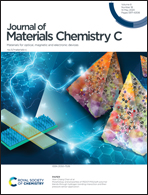Bismuth triiodide complexes: structure, spectroscopy, electronic properties, and memristive properties†
Abstract
A new class of semiconducting materials has been prepared based on bismuth(III) iodide in reaction with ternary amine N-oxides, sulfoxides, and phosphinoxides. Depending on the nature of the ligand, various structures originating from fragments of the BiI3 lattice are formed. The band structure of these materials, optical spectroscopy, and work function measurements indicate the importance of metal–ligand and intraligand interactions in the electronic properties of these complexes. These materials are usually p-type semiconductors, but bidentate benzo(c)cinnoline-N,N′-dioxide results in an n-type semiconducting complex. They can be used for fabrication of MIM (metal–insulator–metal) type devices, which show interesting memristive properties, including modulation of the memristive properties simply due to the change of the type of metallic contact. The operation of the presented devices is based solely on the interface effects and the modulation of the Schottky barrier height. The change of only one of the two electrodes leads to a change from the clockwise to the anticlockwise direction of propagation of the hysteresis loop as well as from the Hebbian to the anti-Hebbian learning mode.



 Please wait while we load your content...
Please wait while we load your content...